Nursing Assignment Report: Socioeconomic Factors in Health Outcomes
VerifiedAdded on 2022/09/09
|10
|3982
|19
Report
AI Summary
This nursing assignment report explores the intricate relationship between health and socioeconomic factors, emphasizing the impact of social determinants on health outcomes. It delves into how factors such as income, education, and access to resources contribute to health inequalities within society. The report examines the structural inequalities, including race, class, and geographic patterns, that affect health. It also discusses the role of policy in shaping health outcomes, addressing how government actions and social policies can either exacerbate or mitigate health disparities. Furthermore, the report analyzes social production and distribution of health, including the influence of social networks, social capital, and work stress on an individual's well-being. It highlights the role of poverty and inequality as significant determinants of health, emphasizing the need for comprehensive interventions to address these complex issues. The assignment draws on various studies and research to support its arguments, offering a detailed overview of the multifaceted nature of health inequality and its implications for healthcare.
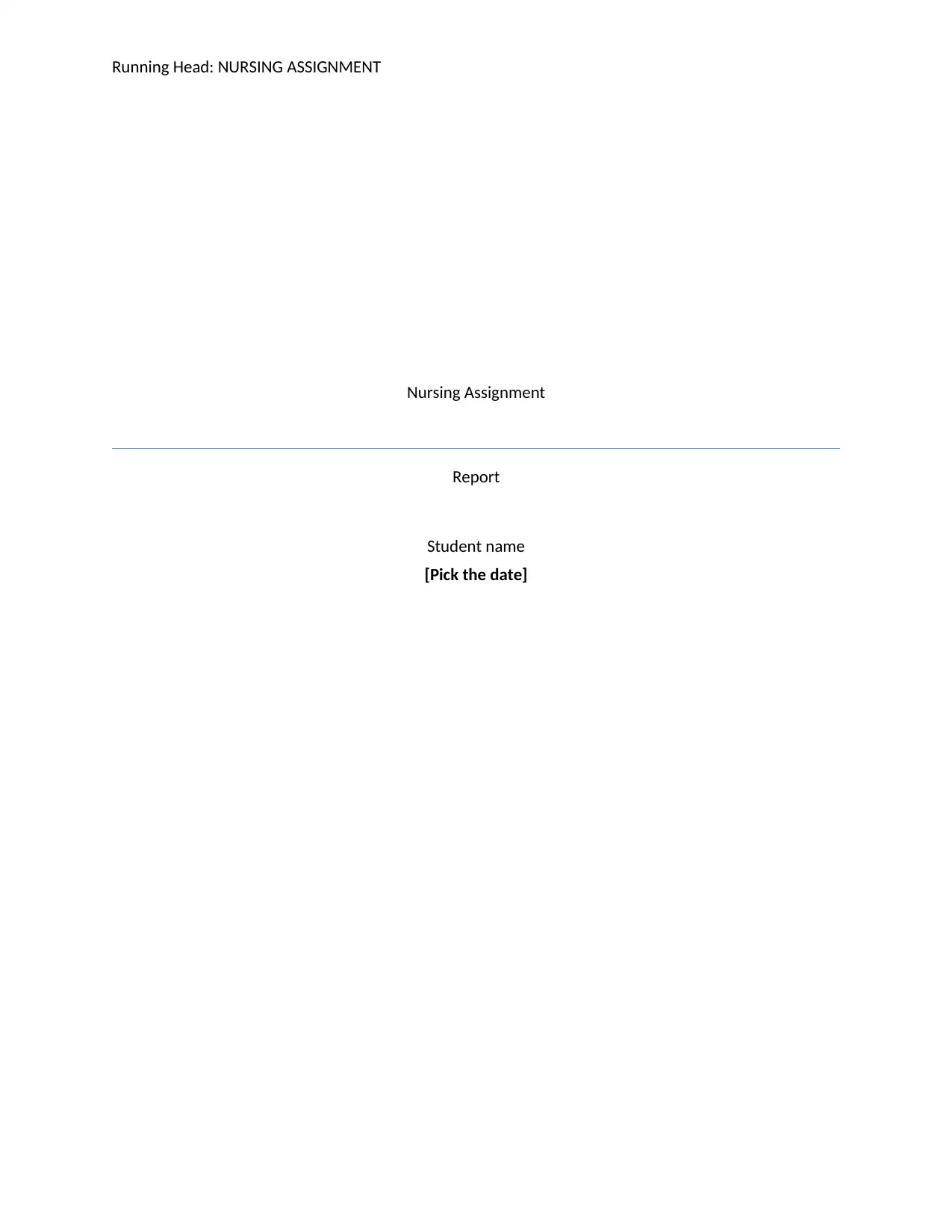
Running Head: NURSING ASSIGNMENT
Nursing Assignment
Report
Student name
[Pick the date]
Nursing Assignment
Report
Student name
[Pick the date]
Paraphrase This Document
Need a fresh take? Get an instant paraphrase of this document with our AI Paraphraser
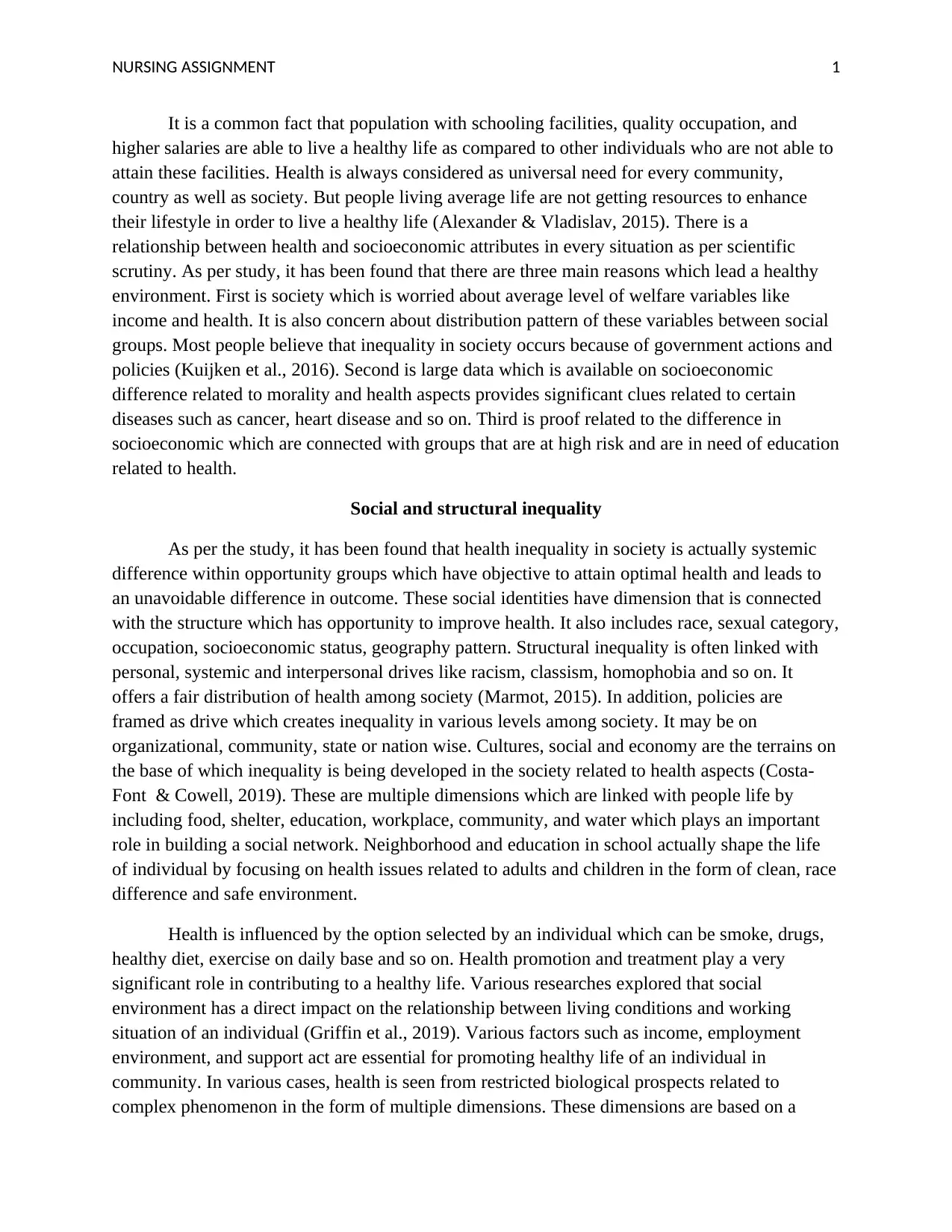
NURSING ASSIGNMENT 1
It is a common fact that population with schooling facilities, quality occupation, and
higher salaries are able to live a healthy life as compared to other individuals who are not able to
attain these facilities. Health is always considered as universal need for every community,
country as well as society. But people living average life are not getting resources to enhance
their lifestyle in order to live a healthy life (Alexander & Vladislav, 2015). There is a
relationship between health and socioeconomic attributes in every situation as per scientific
scrutiny. As per study, it has been found that there are three main reasons which lead a healthy
environment. First is society which is worried about average level of welfare variables like
income and health. It is also concern about distribution pattern of these variables between social
groups. Most people believe that inequality in society occurs because of government actions and
policies (Kuijken et al., 2016). Second is large data which is available on socioeconomic
difference related to morality and health aspects provides significant clues related to certain
diseases such as cancer, heart disease and so on. Third is proof related to the difference in
socioeconomic which are connected with groups that are at high risk and are in need of education
related to health.
Social and structural inequality
As per the study, it has been found that health inequality in society is actually systemic
difference within opportunity groups which have objective to attain optimal health and leads to
an unavoidable difference in outcome. These social identities have dimension that is connected
with the structure which has opportunity to improve health. It also includes race, sexual category,
occupation, socioeconomic status, geography pattern. Structural inequality is often linked with
personal, systemic and interpersonal drives like racism, classism, homophobia and so on. It
offers a fair distribution of health among society (Marmot, 2015). In addition, policies are
framed as drive which creates inequality in various levels among society. It may be on
organizational, community, state or nation wise. Cultures, social and economy are the terrains on
the base of which inequality is being developed in the society related to health aspects (Costa-
Font & Cowell, 2019). These are multiple dimensions which are linked with people life by
including food, shelter, education, workplace, community, and water which plays an important
role in building a social network. Neighborhood and education in school actually shape the life
of individual by focusing on health issues related to adults and children in the form of clean, race
difference and safe environment.
Health is influenced by the option selected by an individual which can be smoke, drugs,
healthy diet, exercise on daily base and so on. Health promotion and treatment play a very
significant role in contributing to a healthy life. Various researches explored that social
environment has a direct impact on the relationship between living conditions and working
situation of an individual (Griffin et al., 2019). Various factors such as income, employment
environment, and support act are essential for promoting healthy life of an individual in
community. In various cases, health is seen from restricted biological prospects related to
complex phenomenon in the form of multiple dimensions. These dimensions are based on a
It is a common fact that population with schooling facilities, quality occupation, and
higher salaries are able to live a healthy life as compared to other individuals who are not able to
attain these facilities. Health is always considered as universal need for every community,
country as well as society. But people living average life are not getting resources to enhance
their lifestyle in order to live a healthy life (Alexander & Vladislav, 2015). There is a
relationship between health and socioeconomic attributes in every situation as per scientific
scrutiny. As per study, it has been found that there are three main reasons which lead a healthy
environment. First is society which is worried about average level of welfare variables like
income and health. It is also concern about distribution pattern of these variables between social
groups. Most people believe that inequality in society occurs because of government actions and
policies (Kuijken et al., 2016). Second is large data which is available on socioeconomic
difference related to morality and health aspects provides significant clues related to certain
diseases such as cancer, heart disease and so on. Third is proof related to the difference in
socioeconomic which are connected with groups that are at high risk and are in need of education
related to health.
Social and structural inequality
As per the study, it has been found that health inequality in society is actually systemic
difference within opportunity groups which have objective to attain optimal health and leads to
an unavoidable difference in outcome. These social identities have dimension that is connected
with the structure which has opportunity to improve health. It also includes race, sexual category,
occupation, socioeconomic status, geography pattern. Structural inequality is often linked with
personal, systemic and interpersonal drives like racism, classism, homophobia and so on. It
offers a fair distribution of health among society (Marmot, 2015). In addition, policies are
framed as drive which creates inequality in various levels among society. It may be on
organizational, community, state or nation wise. Cultures, social and economy are the terrains on
the base of which inequality is being developed in the society related to health aspects (Costa-
Font & Cowell, 2019). These are multiple dimensions which are linked with people life by
including food, shelter, education, workplace, community, and water which plays an important
role in building a social network. Neighborhood and education in school actually shape the life
of individual by focusing on health issues related to adults and children in the form of clean, race
difference and safe environment.
Health is influenced by the option selected by an individual which can be smoke, drugs,
healthy diet, exercise on daily base and so on. Health promotion and treatment play a very
significant role in contributing to a healthy life. Various researches explored that social
environment has a direct impact on the relationship between living conditions and working
situation of an individual (Griffin et al., 2019). Various factors such as income, employment
environment, and support act are essential for promoting healthy life of an individual in
community. In various cases, health is seen from restricted biological prospects related to
complex phenomenon in the form of multiple dimensions. These dimensions are based on a
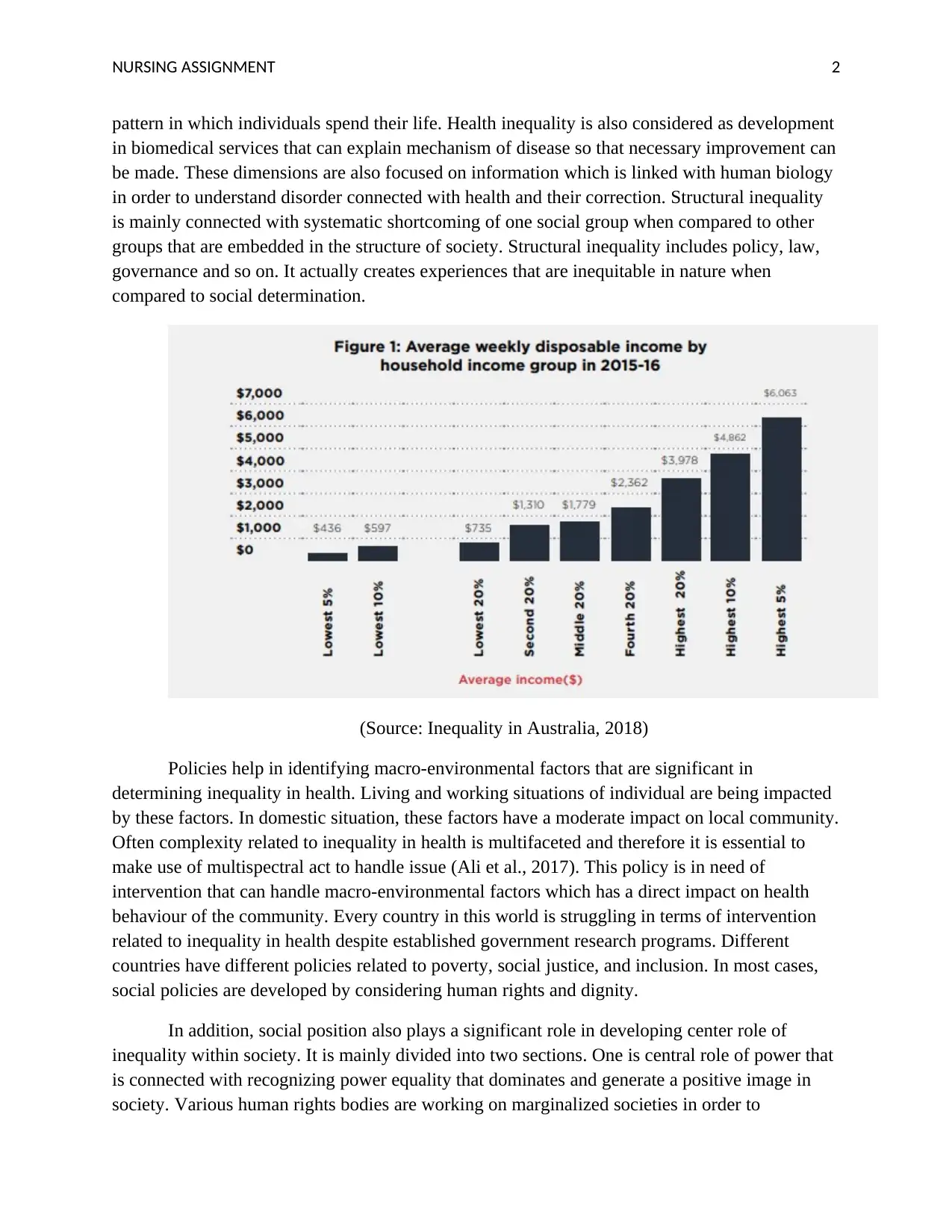
NURSING ASSIGNMENT 2
pattern in which individuals spend their life. Health inequality is also considered as development
in biomedical services that can explain mechanism of disease so that necessary improvement can
be made. These dimensions are also focused on information which is linked with human biology
in order to understand disorder connected with health and their correction. Structural inequality
is mainly connected with systematic shortcoming of one social group when compared to other
groups that are embedded in the structure of society. Structural inequality includes policy, law,
governance and so on. It actually creates experiences that are inequitable in nature when
compared to social determination.
(Source: Inequality in Australia, 2018)
Policies help in identifying macro-environmental factors that are significant in
determining inequality in health. Living and working situations of individual are being impacted
by these factors. In domestic situation, these factors have a moderate impact on local community.
Often complexity related to inequality in health is multifaceted and therefore it is essential to
make use of multispectral act to handle issue (Ali et al., 2017). This policy is in need of
intervention that can handle macro-environmental factors which has a direct impact on health
behaviour of the community. Every country in this world is struggling in terms of intervention
related to inequality in health despite established government research programs. Different
countries have different policies related to poverty, social justice, and inclusion. In most cases,
social policies are developed by considering human rights and dignity.
In addition, social position also plays a significant role in developing center role of
inequality within society. It is mainly divided into two sections. One is central role of power that
is connected with recognizing power equality that dominates and generate a positive image in
society. Various human rights bodies are working on marginalized societies in order to
pattern in which individuals spend their life. Health inequality is also considered as development
in biomedical services that can explain mechanism of disease so that necessary improvement can
be made. These dimensions are also focused on information which is linked with human biology
in order to understand disorder connected with health and their correction. Structural inequality
is mainly connected with systematic shortcoming of one social group when compared to other
groups that are embedded in the structure of society. Structural inequality includes policy, law,
governance and so on. It actually creates experiences that are inequitable in nature when
compared to social determination.
(Source: Inequality in Australia, 2018)
Policies help in identifying macro-environmental factors that are significant in
determining inequality in health. Living and working situations of individual are being impacted
by these factors. In domestic situation, these factors have a moderate impact on local community.
Often complexity related to inequality in health is multifaceted and therefore it is essential to
make use of multispectral act to handle issue (Ali et al., 2017). This policy is in need of
intervention that can handle macro-environmental factors which has a direct impact on health
behaviour of the community. Every country in this world is struggling in terms of intervention
related to inequality in health despite established government research programs. Different
countries have different policies related to poverty, social justice, and inclusion. In most cases,
social policies are developed by considering human rights and dignity.
In addition, social position also plays a significant role in developing center role of
inequality within society. It is mainly divided into two sections. One is central role of power that
is connected with recognizing power equality that dominates and generate a positive image in
society. Various human rights bodies are working on marginalized societies in order to
⊘ This is a preview!⊘
Do you want full access?
Subscribe today to unlock all pages.

Trusted by 1+ million students worldwide
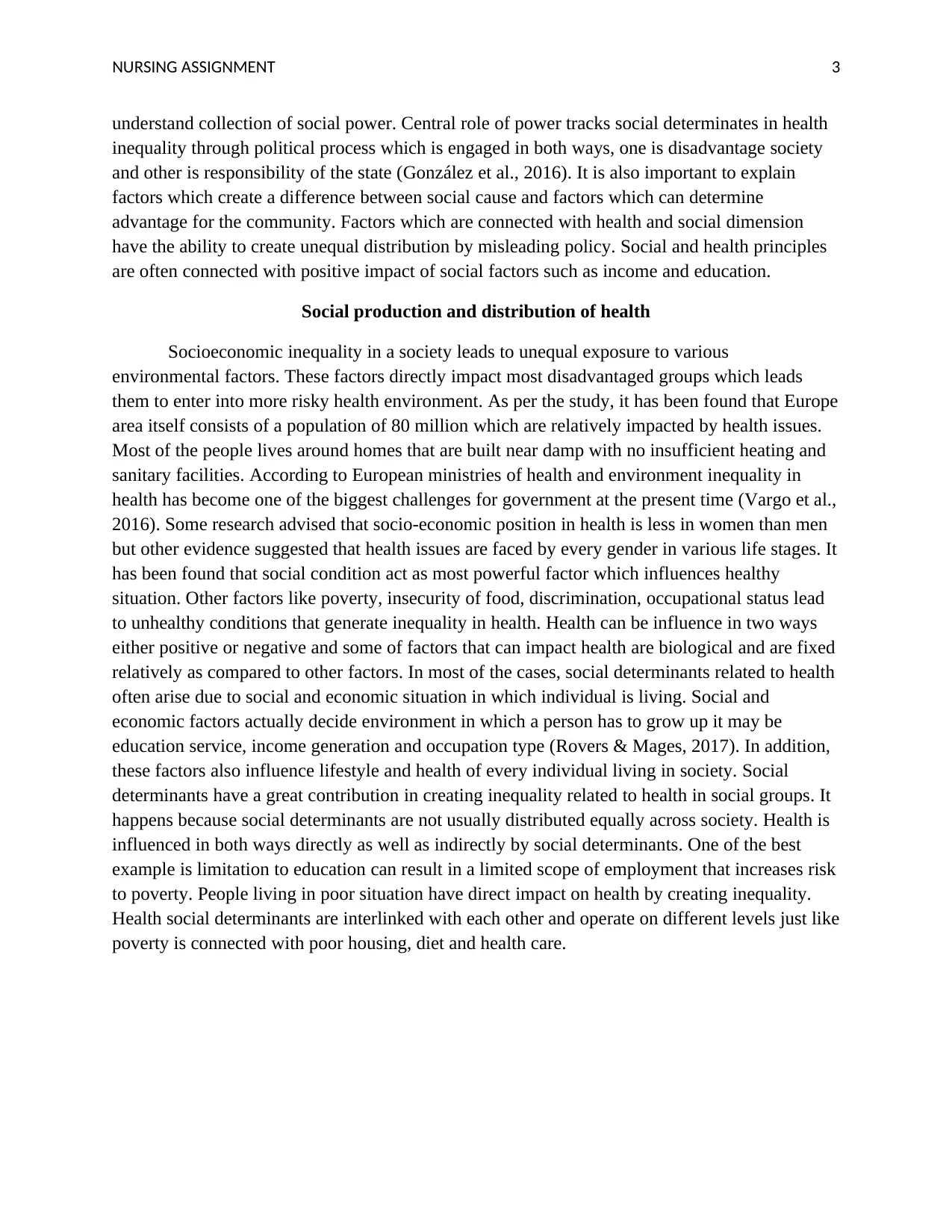
NURSING ASSIGNMENT 3
understand collection of social power. Central role of power tracks social determinates in health
inequality through political process which is engaged in both ways, one is disadvantage society
and other is responsibility of the state (González et al., 2016). It is also important to explain
factors which create a difference between social cause and factors which can determine
advantage for the community. Factors which are connected with health and social dimension
have the ability to create unequal distribution by misleading policy. Social and health principles
are often connected with positive impact of social factors such as income and education.
Social production and distribution of health
Socioeconomic inequality in a society leads to unequal exposure to various
environmental factors. These factors directly impact most disadvantaged groups which leads
them to enter into more risky health environment. As per the study, it has been found that Europe
area itself consists of a population of 80 million which are relatively impacted by health issues.
Most of the people lives around homes that are built near damp with no insufficient heating and
sanitary facilities. According to European ministries of health and environment inequality in
health has become one of the biggest challenges for government at the present time (Vargo et al.,
2016). Some research advised that socio-economic position in health is less in women than men
but other evidence suggested that health issues are faced by every gender in various life stages. It
has been found that social condition act as most powerful factor which influences healthy
situation. Other factors like poverty, insecurity of food, discrimination, occupational status lead
to unhealthy conditions that generate inequality in health. Health can be influence in two ways
either positive or negative and some of factors that can impact health are biological and are fixed
relatively as compared to other factors. In most of the cases, social determinants related to health
often arise due to social and economic situation in which individual is living. Social and
economic factors actually decide environment in which a person has to grow up it may be
education service, income generation and occupation type (Rovers & Mages, 2017). In addition,
these factors also influence lifestyle and health of every individual living in society. Social
determinants have a great contribution in creating inequality related to health in social groups. It
happens because social determinants are not usually distributed equally across society. Health is
influenced in both ways directly as well as indirectly by social determinants. One of the best
example is limitation to education can result in a limited scope of employment that increases risk
to poverty. People living in poor situation have direct impact on health by creating inequality.
Health social determinants are interlinked with each other and operate on different levels just like
poverty is connected with poor housing, diet and health care.
understand collection of social power. Central role of power tracks social determinates in health
inequality through political process which is engaged in both ways, one is disadvantage society
and other is responsibility of the state (González et al., 2016). It is also important to explain
factors which create a difference between social cause and factors which can determine
advantage for the community. Factors which are connected with health and social dimension
have the ability to create unequal distribution by misleading policy. Social and health principles
are often connected with positive impact of social factors such as income and education.
Social production and distribution of health
Socioeconomic inequality in a society leads to unequal exposure to various
environmental factors. These factors directly impact most disadvantaged groups which leads
them to enter into more risky health environment. As per the study, it has been found that Europe
area itself consists of a population of 80 million which are relatively impacted by health issues.
Most of the people lives around homes that are built near damp with no insufficient heating and
sanitary facilities. According to European ministries of health and environment inequality in
health has become one of the biggest challenges for government at the present time (Vargo et al.,
2016). Some research advised that socio-economic position in health is less in women than men
but other evidence suggested that health issues are faced by every gender in various life stages. It
has been found that social condition act as most powerful factor which influences healthy
situation. Other factors like poverty, insecurity of food, discrimination, occupational status lead
to unhealthy conditions that generate inequality in health. Health can be influence in two ways
either positive or negative and some of factors that can impact health are biological and are fixed
relatively as compared to other factors. In most of the cases, social determinants related to health
often arise due to social and economic situation in which individual is living. Social and
economic factors actually decide environment in which a person has to grow up it may be
education service, income generation and occupation type (Rovers & Mages, 2017). In addition,
these factors also influence lifestyle and health of every individual living in society. Social
determinants have a great contribution in creating inequality related to health in social groups. It
happens because social determinants are not usually distributed equally across society. Health is
influenced in both ways directly as well as indirectly by social determinants. One of the best
example is limitation to education can result in a limited scope of employment that increases risk
to poverty. People living in poor situation have direct impact on health by creating inequality.
Health social determinants are interlinked with each other and operate on different levels just like
poverty is connected with poor housing, diet and health care.
Paraphrase This Document
Need a fresh take? Get an instant paraphrase of this document with our AI Paraphraser
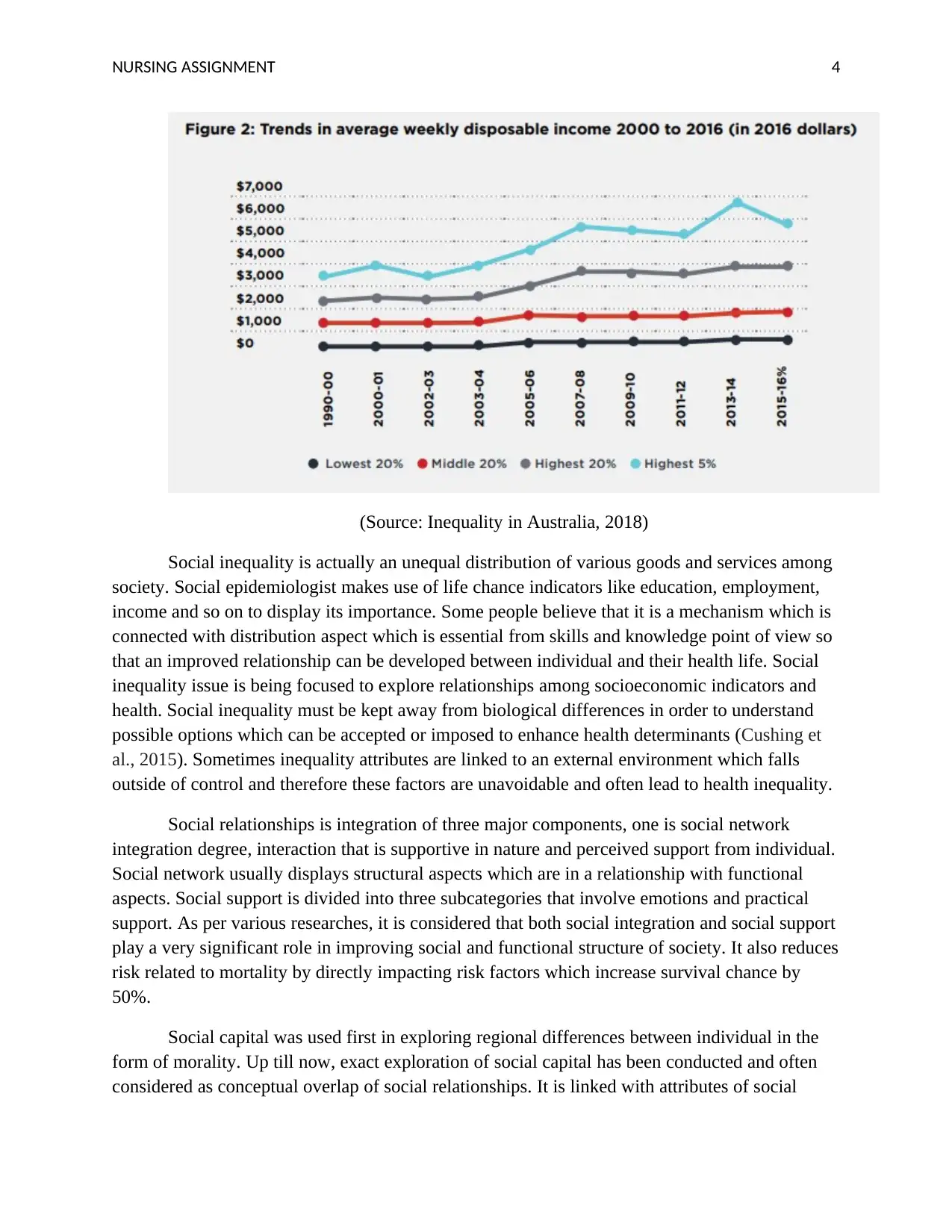
NURSING ASSIGNMENT 4
(Source: Inequality in Australia, 2018)
Social inequality is actually an unequal distribution of various goods and services among
society. Social epidemiologist makes use of life chance indicators like education, employment,
income and so on to display its importance. Some people believe that it is a mechanism which is
connected with distribution aspect which is essential from skills and knowledge point of view so
that an improved relationship can be developed between individual and their health life. Social
inequality issue is being focused to explore relationships among socioeconomic indicators and
health. Social inequality must be kept away from biological differences in order to understand
possible options which can be accepted or imposed to enhance health determinants (Cushing et
al., 2015). Sometimes inequality attributes are linked to an external environment which falls
outside of control and therefore these factors are unavoidable and often lead to health inequality.
Social relationships is integration of three major components, one is social network
integration degree, interaction that is supportive in nature and perceived support from individual.
Social network usually displays structural aspects which are in a relationship with functional
aspects. Social support is divided into three subcategories that involve emotions and practical
support. As per various researches, it is considered that both social integration and social support
play a very significant role in improving social and functional structure of society. It also reduces
risk related to mortality by directly impacting risk factors which increase survival chance by
50%.
Social capital was used first in exploring regional differences between individual in the
form of morality. Up till now, exact exploration of social capital has been conducted and often
considered as conceptual overlap of social relationships. It is linked with attributes of social
(Source: Inequality in Australia, 2018)
Social inequality is actually an unequal distribution of various goods and services among
society. Social epidemiologist makes use of life chance indicators like education, employment,
income and so on to display its importance. Some people believe that it is a mechanism which is
connected with distribution aspect which is essential from skills and knowledge point of view so
that an improved relationship can be developed between individual and their health life. Social
inequality issue is being focused to explore relationships among socioeconomic indicators and
health. Social inequality must be kept away from biological differences in order to understand
possible options which can be accepted or imposed to enhance health determinants (Cushing et
al., 2015). Sometimes inequality attributes are linked to an external environment which falls
outside of control and therefore these factors are unavoidable and often lead to health inequality.
Social relationships is integration of three major components, one is social network
integration degree, interaction that is supportive in nature and perceived support from individual.
Social network usually displays structural aspects which are in a relationship with functional
aspects. Social support is divided into three subcategories that involve emotions and practical
support. As per various researches, it is considered that both social integration and social support
play a very significant role in improving social and functional structure of society. It also reduces
risk related to mortality by directly impacting risk factors which increase survival chance by
50%.
Social capital was used first in exploring regional differences between individual in the
form of morality. Up till now, exact exploration of social capital has been conducted and often
considered as conceptual overlap of social relationships. It is linked with attributes of social
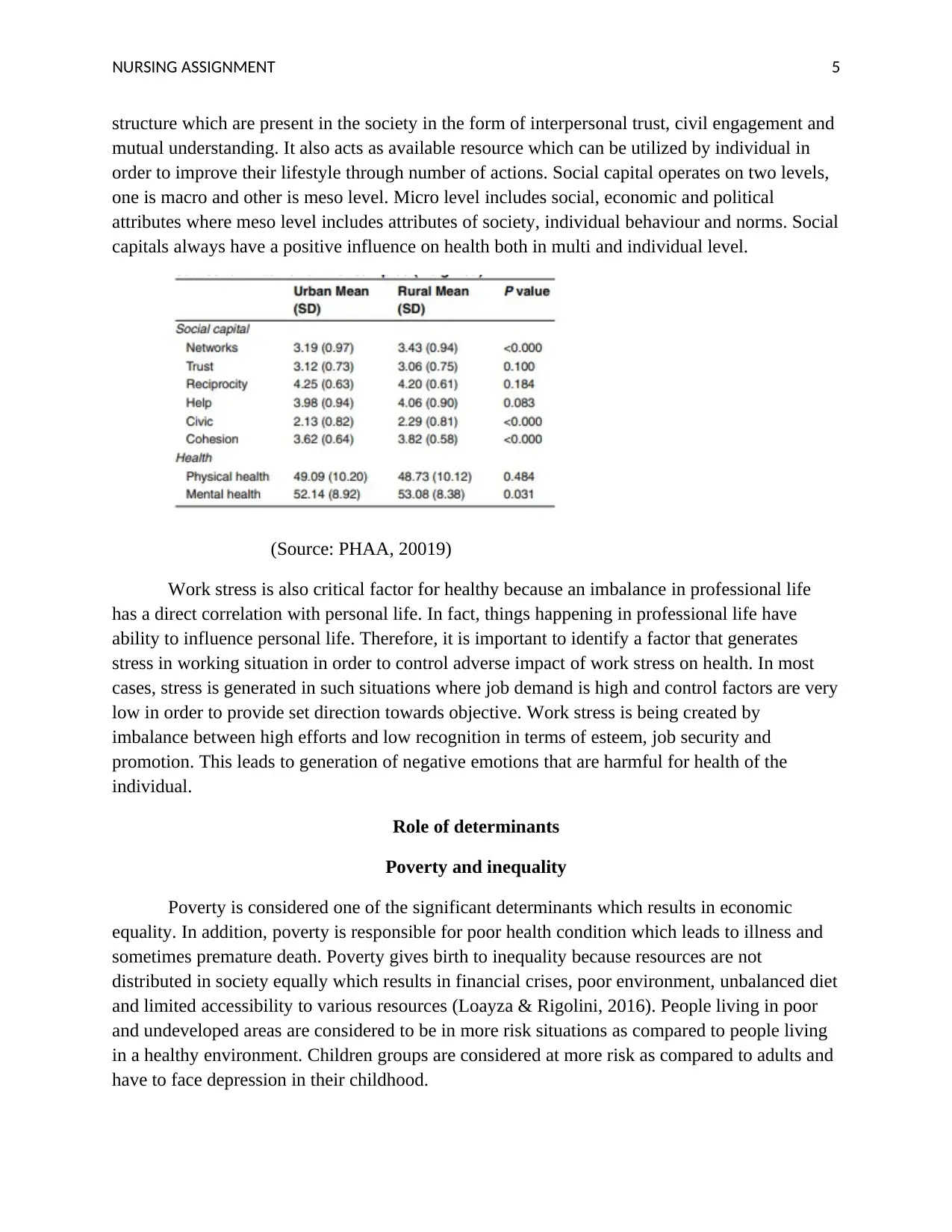
NURSING ASSIGNMENT 5
structure which are present in the society in the form of interpersonal trust, civil engagement and
mutual understanding. It also acts as available resource which can be utilized by individual in
order to improve their lifestyle through number of actions. Social capital operates on two levels,
one is macro and other is meso level. Micro level includes social, economic and political
attributes where meso level includes attributes of society, individual behaviour and norms. Social
capitals always have a positive influence on health both in multi and individual level.
(Source: PHAA, 20019)
Work stress is also critical factor for healthy because an imbalance in professional life
has a direct correlation with personal life. In fact, things happening in professional life have
ability to influence personal life. Therefore, it is important to identify a factor that generates
stress in working situation in order to control adverse impact of work stress on health. In most
cases, stress is generated in such situations where job demand is high and control factors are very
low in order to provide set direction towards objective. Work stress is being created by
imbalance between high efforts and low recognition in terms of esteem, job security and
promotion. This leads to generation of negative emotions that are harmful for health of the
individual.
Role of determinants
Poverty and inequality
Poverty is considered one of the significant determinants which results in economic
equality. In addition, poverty is responsible for poor health condition which leads to illness and
sometimes premature death. Poverty gives birth to inequality because resources are not
distributed in society equally which results in financial crises, poor environment, unbalanced diet
and limited accessibility to various resources (Loayza & Rigolini, 2016). People living in poor
and undeveloped areas are considered to be in more risk situations as compared to people living
in a healthy environment. Children groups are considered at more risk as compared to adults and
have to face depression in their childhood.
structure which are present in the society in the form of interpersonal trust, civil engagement and
mutual understanding. It also acts as available resource which can be utilized by individual in
order to improve their lifestyle through number of actions. Social capital operates on two levels,
one is macro and other is meso level. Micro level includes social, economic and political
attributes where meso level includes attributes of society, individual behaviour and norms. Social
capitals always have a positive influence on health both in multi and individual level.
(Source: PHAA, 20019)
Work stress is also critical factor for healthy because an imbalance in professional life
has a direct correlation with personal life. In fact, things happening in professional life have
ability to influence personal life. Therefore, it is important to identify a factor that generates
stress in working situation in order to control adverse impact of work stress on health. In most
cases, stress is generated in such situations where job demand is high and control factors are very
low in order to provide set direction towards objective. Work stress is being created by
imbalance between high efforts and low recognition in terms of esteem, job security and
promotion. This leads to generation of negative emotions that are harmful for health of the
individual.
Role of determinants
Poverty and inequality
Poverty is considered one of the significant determinants which results in economic
equality. In addition, poverty is responsible for poor health condition which leads to illness and
sometimes premature death. Poverty gives birth to inequality because resources are not
distributed in society equally which results in financial crises, poor environment, unbalanced diet
and limited accessibility to various resources (Loayza & Rigolini, 2016). People living in poor
and undeveloped areas are considered to be in more risk situations as compared to people living
in a healthy environment. Children groups are considered at more risk as compared to adults and
have to face depression in their childhood.
⊘ This is a preview!⊘
Do you want full access?
Subscribe today to unlock all pages.

Trusted by 1+ million students worldwide
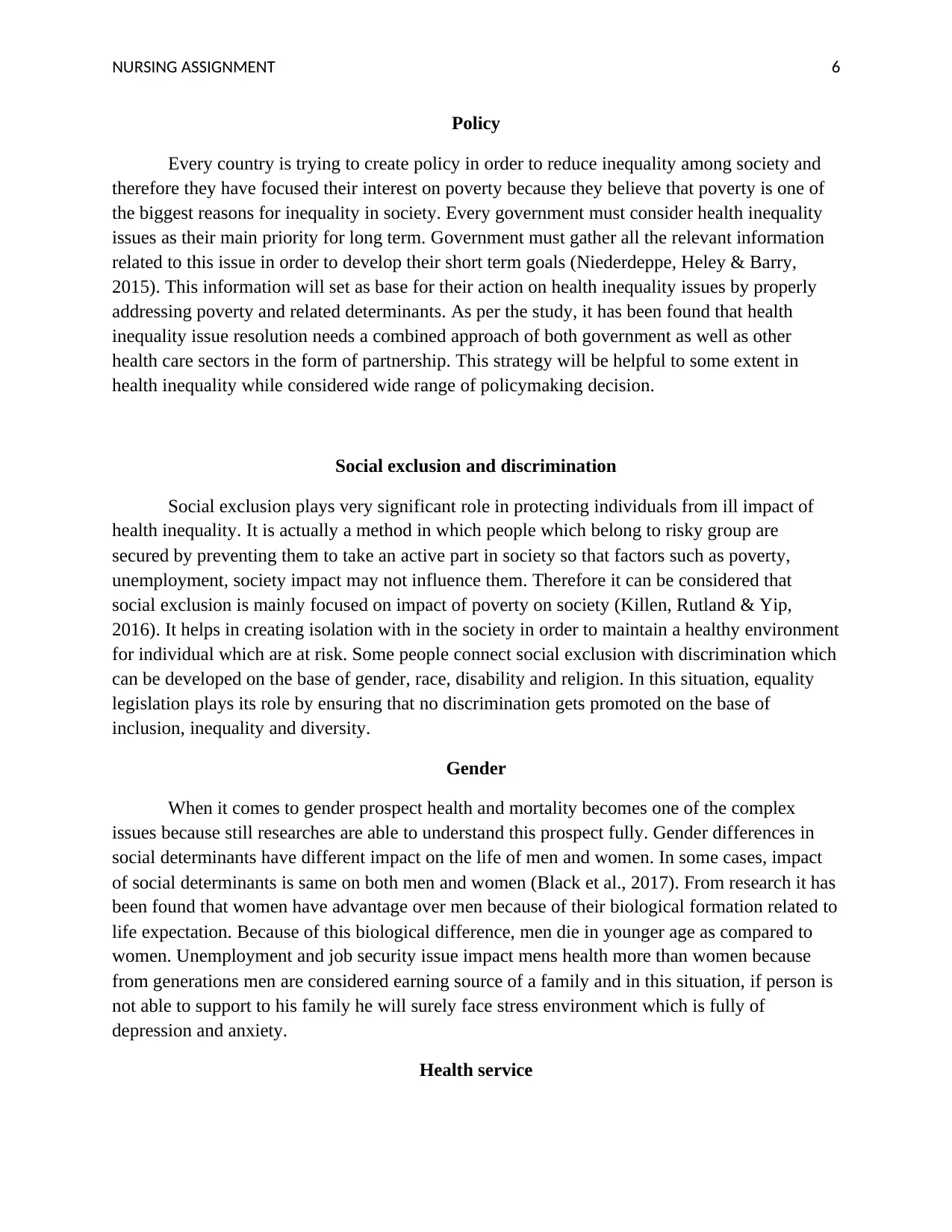
NURSING ASSIGNMENT 6
Policy
Every country is trying to create policy in order to reduce inequality among society and
therefore they have focused their interest on poverty because they believe that poverty is one of
the biggest reasons for inequality in society. Every government must consider health inequality
issues as their main priority for long term. Government must gather all the relevant information
related to this issue in order to develop their short term goals (Niederdeppe, Heley & Barry,
2015). This information will set as base for their action on health inequality issues by properly
addressing poverty and related determinants. As per the study, it has been found that health
inequality issue resolution needs a combined approach of both government as well as other
health care sectors in the form of partnership. This strategy will be helpful to some extent in
health inequality while considered wide range of policymaking decision.
Social exclusion and discrimination
Social exclusion plays very significant role in protecting individuals from ill impact of
health inequality. It is actually a method in which people which belong to risky group are
secured by preventing them to take an active part in society so that factors such as poverty,
unemployment, society impact may not influence them. Therefore it can be considered that
social exclusion is mainly focused on impact of poverty on society (Killen, Rutland & Yip,
2016). It helps in creating isolation with in the society in order to maintain a healthy environment
for individual which are at risk. Some people connect social exclusion with discrimination which
can be developed on the base of gender, race, disability and religion. In this situation, equality
legislation plays its role by ensuring that no discrimination gets promoted on the base of
inclusion, inequality and diversity.
Gender
When it comes to gender prospect health and mortality becomes one of the complex
issues because still researches are able to understand this prospect fully. Gender differences in
social determinants have different impact on the life of men and women. In some cases, impact
of social determinants is same on both men and women (Black et al., 2017). From research it has
been found that women have advantage over men because of their biological formation related to
life expectation. Because of this biological difference, men die in younger age as compared to
women. Unemployment and job security issue impact mens health more than women because
from generations men are considered earning source of a family and in this situation, if person is
not able to support to his family he will surely face stress environment which is fully of
depression and anxiety.
Health service
Policy
Every country is trying to create policy in order to reduce inequality among society and
therefore they have focused their interest on poverty because they believe that poverty is one of
the biggest reasons for inequality in society. Every government must consider health inequality
issues as their main priority for long term. Government must gather all the relevant information
related to this issue in order to develop their short term goals (Niederdeppe, Heley & Barry,
2015). This information will set as base for their action on health inequality issues by properly
addressing poverty and related determinants. As per the study, it has been found that health
inequality issue resolution needs a combined approach of both government as well as other
health care sectors in the form of partnership. This strategy will be helpful to some extent in
health inequality while considered wide range of policymaking decision.
Social exclusion and discrimination
Social exclusion plays very significant role in protecting individuals from ill impact of
health inequality. It is actually a method in which people which belong to risky group are
secured by preventing them to take an active part in society so that factors such as poverty,
unemployment, society impact may not influence them. Therefore it can be considered that
social exclusion is mainly focused on impact of poverty on society (Killen, Rutland & Yip,
2016). It helps in creating isolation with in the society in order to maintain a healthy environment
for individual which are at risk. Some people connect social exclusion with discrimination which
can be developed on the base of gender, race, disability and religion. In this situation, equality
legislation plays its role by ensuring that no discrimination gets promoted on the base of
inclusion, inequality and diversity.
Gender
When it comes to gender prospect health and mortality becomes one of the complex
issues because still researches are able to understand this prospect fully. Gender differences in
social determinants have different impact on the life of men and women. In some cases, impact
of social determinants is same on both men and women (Black et al., 2017). From research it has
been found that women have advantage over men because of their biological formation related to
life expectation. Because of this biological difference, men die in younger age as compared to
women. Unemployment and job security issue impact mens health more than women because
from generations men are considered earning source of a family and in this situation, if person is
not able to support to his family he will surely face stress environment which is fully of
depression and anxiety.
Health service
Paraphrase This Document
Need a fresh take? Get an instant paraphrase of this document with our AI Paraphraser
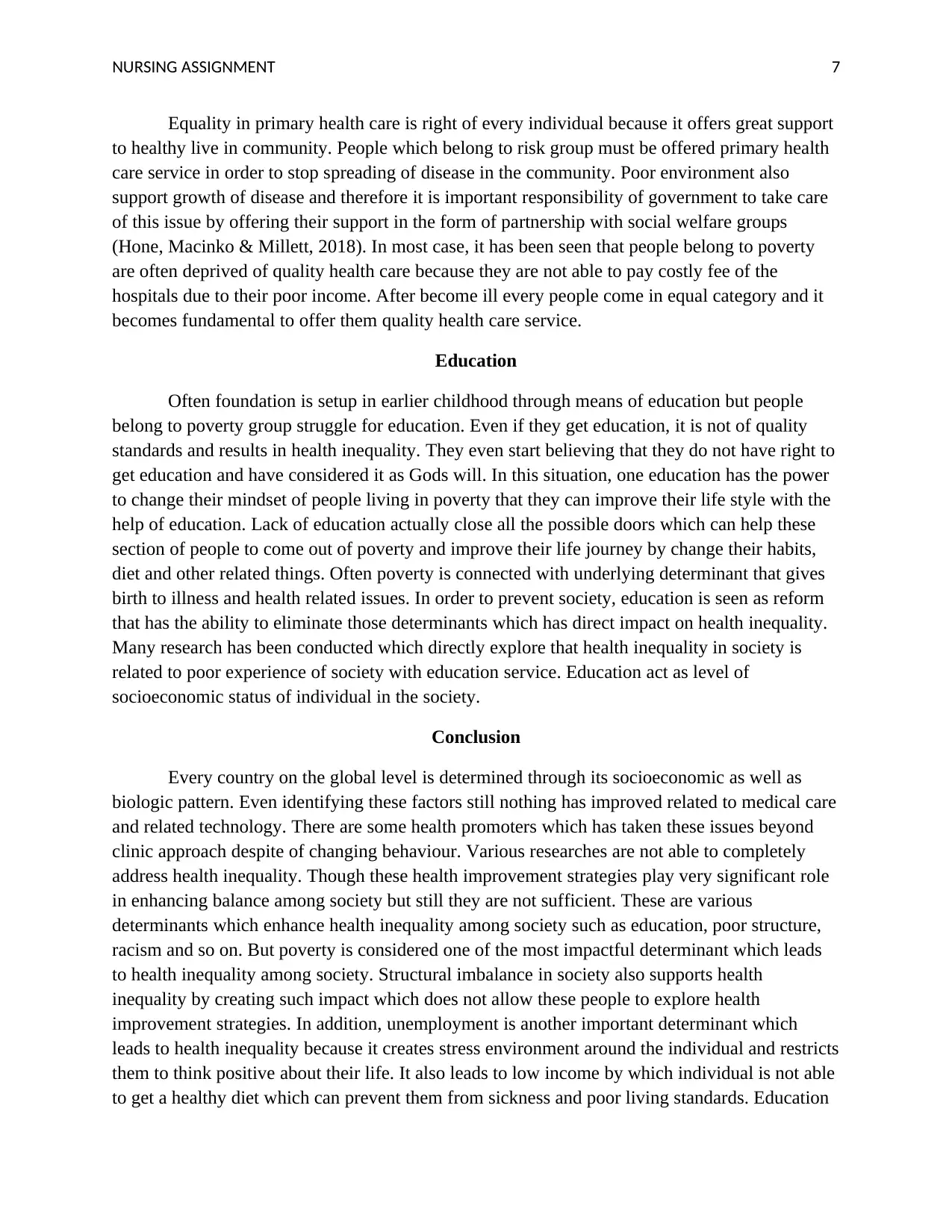
NURSING ASSIGNMENT 7
Equality in primary health care is right of every individual because it offers great support
to healthy live in community. People which belong to risk group must be offered primary health
care service in order to stop spreading of disease in the community. Poor environment also
support growth of disease and therefore it is important responsibility of government to take care
of this issue by offering their support in the form of partnership with social welfare groups
(Hone, Macinko & Millett, 2018). In most case, it has been seen that people belong to poverty
are often deprived of quality health care because they are not able to pay costly fee of the
hospitals due to their poor income. After become ill every people come in equal category and it
becomes fundamental to offer them quality health care service.
Education
Often foundation is setup in earlier childhood through means of education but people
belong to poverty group struggle for education. Even if they get education, it is not of quality
standards and results in health inequality. They even start believing that they do not have right to
get education and have considered it as Gods will. In this situation, one education has the power
to change their mindset of people living in poverty that they can improve their life style with the
help of education. Lack of education actually close all the possible doors which can help these
section of people to come out of poverty and improve their life journey by change their habits,
diet and other related things. Often poverty is connected with underlying determinant that gives
birth to illness and health related issues. In order to prevent society, education is seen as reform
that has the ability to eliminate those determinants which has direct impact on health inequality.
Many research has been conducted which directly explore that health inequality in society is
related to poor experience of society with education service. Education act as level of
socioeconomic status of individual in the society.
Conclusion
Every country on the global level is determined through its socioeconomic as well as
biologic pattern. Even identifying these factors still nothing has improved related to medical care
and related technology. There are some health promoters which has taken these issues beyond
clinic approach despite of changing behaviour. Various researches are not able to completely
address health inequality. Though these health improvement strategies play very significant role
in enhancing balance among society but still they are not sufficient. These are various
determinants which enhance health inequality among society such as education, poor structure,
racism and so on. But poverty is considered one of the most impactful determinant which leads
to health inequality among society. Structural imbalance in society also supports health
inequality by creating such impact which does not allow these people to explore health
improvement strategies. In addition, unemployment is another important determinant which
leads to health inequality because it creates stress environment around the individual and restricts
them to think positive about their life. It also leads to low income by which individual is not able
to get a healthy diet which can prevent them from sickness and poor living standards. Education
Equality in primary health care is right of every individual because it offers great support
to healthy live in community. People which belong to risk group must be offered primary health
care service in order to stop spreading of disease in the community. Poor environment also
support growth of disease and therefore it is important responsibility of government to take care
of this issue by offering their support in the form of partnership with social welfare groups
(Hone, Macinko & Millett, 2018). In most case, it has been seen that people belong to poverty
are often deprived of quality health care because they are not able to pay costly fee of the
hospitals due to their poor income. After become ill every people come in equal category and it
becomes fundamental to offer them quality health care service.
Education
Often foundation is setup in earlier childhood through means of education but people
belong to poverty group struggle for education. Even if they get education, it is not of quality
standards and results in health inequality. They even start believing that they do not have right to
get education and have considered it as Gods will. In this situation, one education has the power
to change their mindset of people living in poverty that they can improve their life style with the
help of education. Lack of education actually close all the possible doors which can help these
section of people to come out of poverty and improve their life journey by change their habits,
diet and other related things. Often poverty is connected with underlying determinant that gives
birth to illness and health related issues. In order to prevent society, education is seen as reform
that has the ability to eliminate those determinants which has direct impact on health inequality.
Many research has been conducted which directly explore that health inequality in society is
related to poor experience of society with education service. Education act as level of
socioeconomic status of individual in the society.
Conclusion
Every country on the global level is determined through its socioeconomic as well as
biologic pattern. Even identifying these factors still nothing has improved related to medical care
and related technology. There are some health promoters which has taken these issues beyond
clinic approach despite of changing behaviour. Various researches are not able to completely
address health inequality. Though these health improvement strategies play very significant role
in enhancing balance among society but still they are not sufficient. These are various
determinants which enhance health inequality among society such as education, poor structure,
racism and so on. But poverty is considered one of the most impactful determinant which leads
to health inequality among society. Structural imbalance in society also supports health
inequality by creating such impact which does not allow these people to explore health
improvement strategies. In addition, unemployment is another important determinant which
leads to health inequality because it creates stress environment around the individual and restricts
them to think positive about their life. It also leads to low income by which individual is not able
to get a healthy diet which can prevent them from sickness and poor living standards. Education
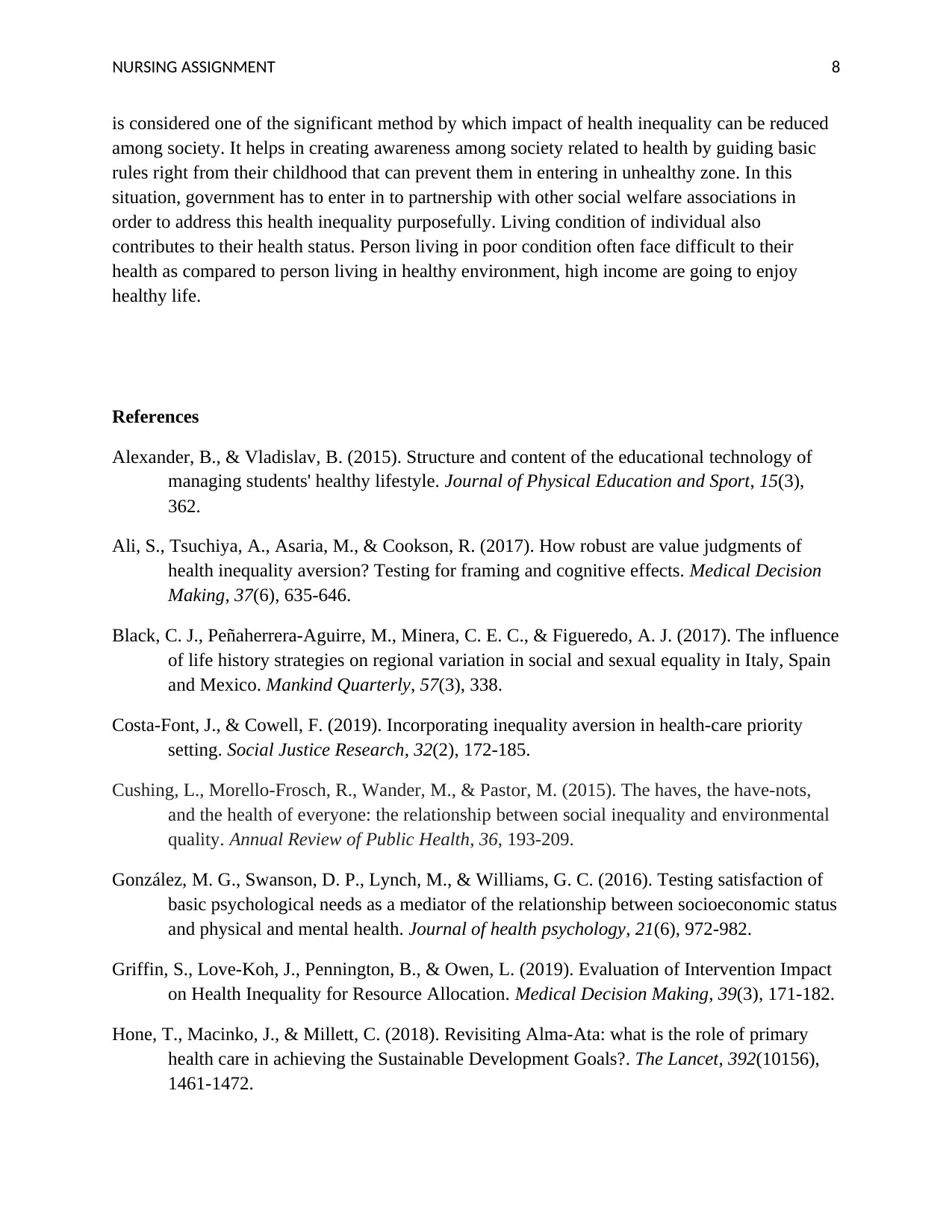
NURSING ASSIGNMENT 8
is considered one of the significant method by which impact of health inequality can be reduced
among society. It helps in creating awareness among society related to health by guiding basic
rules right from their childhood that can prevent them in entering in unhealthy zone. In this
situation, government has to enter in to partnership with other social welfare associations in
order to address this health inequality purposefully. Living condition of individual also
contributes to their health status. Person living in poor condition often face difficult to their
health as compared to person living in healthy environment, high income are going to enjoy
healthy life.
References
Alexander, B., & Vladislav, B. (2015). Structure and content of the educational technology of
managing students' healthy lifestyle. Journal of Physical Education and Sport, 15(3),
362.
Ali, S., Tsuchiya, A., Asaria, M., & Cookson, R. (2017). How robust are value judgments of
health inequality aversion? Testing for framing and cognitive effects. Medical Decision
Making, 37(6), 635-646.
Black, C. J., Peñaherrera-Aguirre, M., Minera, C. E. C., & Figueredo, A. J. (2017). The influence
of life history strategies on regional variation in social and sexual equality in Italy, Spain
and Mexico. Mankind Quarterly, 57(3), 338.
Costa-Font, J., & Cowell, F. (2019). Incorporating inequality aversion in health-care priority
setting. Social Justice Research, 32(2), 172-185.
Cushing, L., Morello-Frosch, R., Wander, M., & Pastor, M. (2015). The haves, the have-nots,
and the health of everyone: the relationship between social inequality and environmental
quality. Annual Review of Public Health, 36, 193-209.
González, M. G., Swanson, D. P., Lynch, M., & Williams, G. C. (2016). Testing satisfaction of
basic psychological needs as a mediator of the relationship between socioeconomic status
and physical and mental health. Journal of health psychology, 21(6), 972-982.
Griffin, S., Love-Koh, J., Pennington, B., & Owen, L. (2019). Evaluation of Intervention Impact
on Health Inequality for Resource Allocation. Medical Decision Making, 39(3), 171-182.
Hone, T., Macinko, J., & Millett, C. (2018). Revisiting Alma-Ata: what is the role of primary
health care in achieving the Sustainable Development Goals?. The Lancet, 392(10156),
1461-1472.
is considered one of the significant method by which impact of health inequality can be reduced
among society. It helps in creating awareness among society related to health by guiding basic
rules right from their childhood that can prevent them in entering in unhealthy zone. In this
situation, government has to enter in to partnership with other social welfare associations in
order to address this health inequality purposefully. Living condition of individual also
contributes to their health status. Person living in poor condition often face difficult to their
health as compared to person living in healthy environment, high income are going to enjoy
healthy life.
References
Alexander, B., & Vladislav, B. (2015). Structure and content of the educational technology of
managing students' healthy lifestyle. Journal of Physical Education and Sport, 15(3),
362.
Ali, S., Tsuchiya, A., Asaria, M., & Cookson, R. (2017). How robust are value judgments of
health inequality aversion? Testing for framing and cognitive effects. Medical Decision
Making, 37(6), 635-646.
Black, C. J., Peñaherrera-Aguirre, M., Minera, C. E. C., & Figueredo, A. J. (2017). The influence
of life history strategies on regional variation in social and sexual equality in Italy, Spain
and Mexico. Mankind Quarterly, 57(3), 338.
Costa-Font, J., & Cowell, F. (2019). Incorporating inequality aversion in health-care priority
setting. Social Justice Research, 32(2), 172-185.
Cushing, L., Morello-Frosch, R., Wander, M., & Pastor, M. (2015). The haves, the have-nots,
and the health of everyone: the relationship between social inequality and environmental
quality. Annual Review of Public Health, 36, 193-209.
González, M. G., Swanson, D. P., Lynch, M., & Williams, G. C. (2016). Testing satisfaction of
basic psychological needs as a mediator of the relationship between socioeconomic status
and physical and mental health. Journal of health psychology, 21(6), 972-982.
Griffin, S., Love-Koh, J., Pennington, B., & Owen, L. (2019). Evaluation of Intervention Impact
on Health Inequality for Resource Allocation. Medical Decision Making, 39(3), 171-182.
Hone, T., Macinko, J., & Millett, C. (2018). Revisiting Alma-Ata: what is the role of primary
health care in achieving the Sustainable Development Goals?. The Lancet, 392(10156),
1461-1472.
⊘ This is a preview!⊘
Do you want full access?
Subscribe today to unlock all pages.

Trusted by 1+ million students worldwide
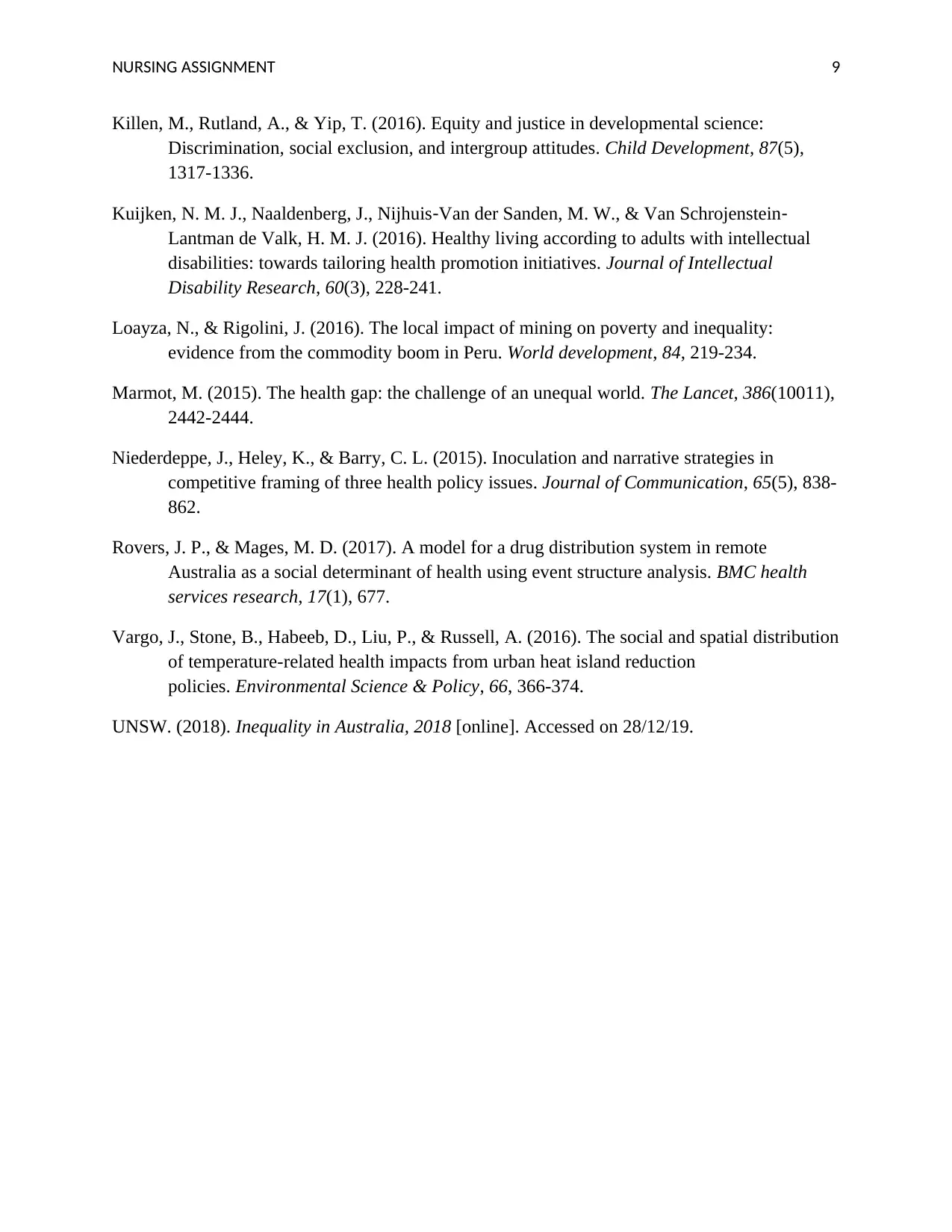
NURSING ASSIGNMENT 9
Killen, M., Rutland, A., & Yip, T. (2016). Equity and justice in developmental science:
Discrimination, social exclusion, and intergroup attitudes. Child Development, 87(5),
1317-1336.
Kuijken, N. M. J., Naaldenberg, J., Nijhuis‐Van der Sanden, M. W., & Van Schrojenstein‐
Lantman de Valk, H. M. J. (2016). Healthy living according to adults with intellectual
disabilities: towards tailoring health promotion initiatives. Journal of Intellectual
Disability Research, 60(3), 228-241.
Loayza, N., & Rigolini, J. (2016). The local impact of mining on poverty and inequality:
evidence from the commodity boom in Peru. World development, 84, 219-234.
Marmot, M. (2015). The health gap: the challenge of an unequal world. The Lancet, 386(10011),
2442-2444.
Niederdeppe, J., Heley, K., & Barry, C. L. (2015). Inoculation and narrative strategies in
competitive framing of three health policy issues. Journal of Communication, 65(5), 838-
862.
Rovers, J. P., & Mages, M. D. (2017). A model for a drug distribution system in remote
Australia as a social determinant of health using event structure analysis. BMC health
services research, 17(1), 677.
Vargo, J., Stone, B., Habeeb, D., Liu, P., & Russell, A. (2016). The social and spatial distribution
of temperature-related health impacts from urban heat island reduction
policies. Environmental Science & Policy, 66, 366-374.
UNSW. (2018). Inequality in Australia, 2018 [online]. Accessed on 28/12/19.
Killen, M., Rutland, A., & Yip, T. (2016). Equity and justice in developmental science:
Discrimination, social exclusion, and intergroup attitudes. Child Development, 87(5),
1317-1336.
Kuijken, N. M. J., Naaldenberg, J., Nijhuis‐Van der Sanden, M. W., & Van Schrojenstein‐
Lantman de Valk, H. M. J. (2016). Healthy living according to adults with intellectual
disabilities: towards tailoring health promotion initiatives. Journal of Intellectual
Disability Research, 60(3), 228-241.
Loayza, N., & Rigolini, J. (2016). The local impact of mining on poverty and inequality:
evidence from the commodity boom in Peru. World development, 84, 219-234.
Marmot, M. (2015). The health gap: the challenge of an unequal world. The Lancet, 386(10011),
2442-2444.
Niederdeppe, J., Heley, K., & Barry, C. L. (2015). Inoculation and narrative strategies in
competitive framing of three health policy issues. Journal of Communication, 65(5), 838-
862.
Rovers, J. P., & Mages, M. D. (2017). A model for a drug distribution system in remote
Australia as a social determinant of health using event structure analysis. BMC health
services research, 17(1), 677.
Vargo, J., Stone, B., Habeeb, D., Liu, P., & Russell, A. (2016). The social and spatial distribution
of temperature-related health impacts from urban heat island reduction
policies. Environmental Science & Policy, 66, 366-374.
UNSW. (2018). Inequality in Australia, 2018 [online]. Accessed on 28/12/19.
1 out of 10
Related Documents
Your All-in-One AI-Powered Toolkit for Academic Success.
+13062052269
info@desklib.com
Available 24*7 on WhatsApp / Email
![[object Object]](/_next/static/media/star-bottom.7253800d.svg)
Unlock your academic potential
Copyright © 2020–2025 A2Z Services. All Rights Reserved. Developed and managed by ZUCOL.



